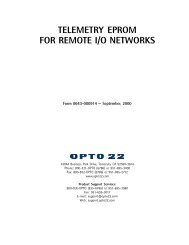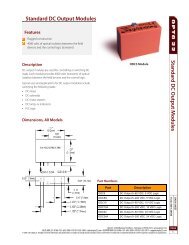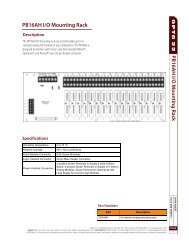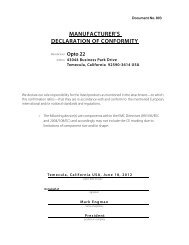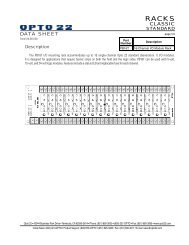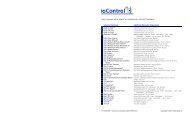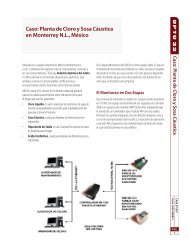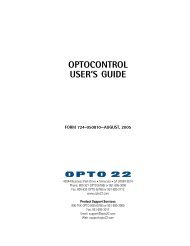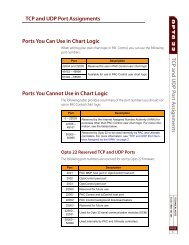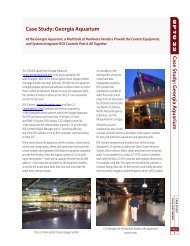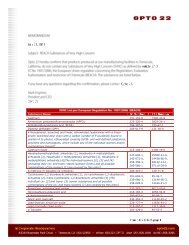Modbus Integration Kit for PAC Control User's Guide - Opto 22
Modbus Integration Kit for PAC Control User's Guide - Opto 22
Modbus Integration Kit for PAC Control User's Guide - Opto 22
Create successful ePaper yourself
Turn your PDF publications into a flip-book with our unique Google optimized e-Paper software.
EXAMPLES USING THE MASTER REGISTER PARAMETER<br />
For Input Registers and Holding Registers, when using 32-bit data types, there is always a<br />
two-to-one correlation between the number of (16-bit) registers in the slave and the number of<br />
(32-bit) table elements used <strong>for</strong> the data in the master. This is because most slave devices store data<br />
in 16-bit registers. Consequently, 32-bit data in these devices are stored in two consecutive 16-bit<br />
registers.<br />
For 32-bit data, the Master Register Offset and Master Register Mode parameter affects the starting<br />
register number used in the master data tables, but also the quantity of registers accessed in the<br />
slave.<br />
Example 3A: When the Master Register Offset parameter is 0, the subroutine uses the value of the<br />
Start Register parameter as the starting register number in the slave and also as the starting table<br />
index in the master.<br />
In addition, the Qty of H Registers (or Qty of I Registers) parameter determines the quantity of 16-bit<br />
registers read from or written to the slave. The number of 32-bit registers in the master will be half<br />
the quantity of this parameter.<br />
The Quantity of H Registers (or Quantity of I Registers) parameter must be an even number because<br />
two registers are used <strong>for</strong> these data types.<br />
The Start Register parameter in most slave devices will be an odd number.<br />
The Start Register value will determine the first table index used <strong>for</strong> the 32-bit data in the master.<br />
Additional 32-bit values will be put into subsequent odd indexes of the table so that the table<br />
indexes in the master will match the first register number <strong>for</strong> each set of two consecutive 16-bit<br />
registers in the slave. All even table indexes are unused.<br />
Parameter Value Comment<br />
Master Register Offset 0<br />
Master Register Mode<br />
False<br />
It will read the Quantity of registers and write every other<br />
index of the <strong>Modbus</strong> table.<br />
Slave Register 7001 must be an odd number<br />
Qty of I Registers 4 must be an even number<br />
Data Type 2,3,4 or 5 data type is 32-bit<br />
Master<br />
Table Index<br />
Slave<br />
Register Number<br />
7001 ← 7001<br />
7002<br />
7003 ← 7003<br />
7004<br />
Example 3B: When the Master Register Offset parameter is non zero, the subroutine uses the value<br />
of the Start Register parameter as the starting register number in the Slave and it uses the value of<br />
the Start Register parameter + the Master Register Offset as the starting table index in the master.<br />
12<br />
<strong>Modbus</strong> <strong>Integration</strong> <strong>Kit</strong> <strong>for</strong> <strong>PAC</strong> <strong>Control</strong> User’s <strong>Guide</strong>



